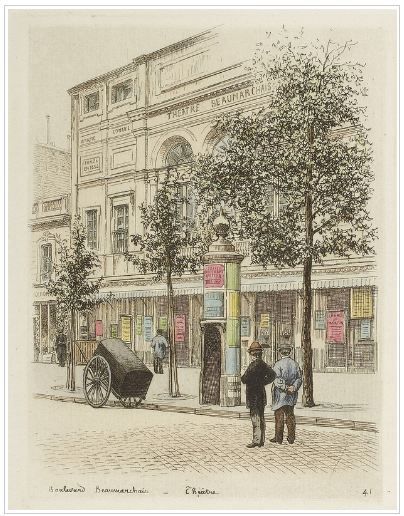.
Paris’ celebrated Père Lachaise cemetery is the resting place of many world-famous and infamous as well as an outdoor art gallery. This oasis of tranquility and greenery sees one million visitors a year.
The hill, on which the cemetery is established, originally served as a site for the rest and convalescence of Jesuit priests. It was named after the confessor of King Louis XIV, Père de la Chaise.
,
.
History

The Holy Innocents Cemetery
The centrally situated Holy Innocents’ Cemetery, where Parisians buried their dead, was used from the Middle Ages until the late 18th century. It was closed in 1785 when Parisians could no longer bear the repugnant stench emanating from the graves. Serious overcrowding pushed up the price of burial space, and bodies were packed so closely together that many graves collapsed through the cellar walls of surrounding houses. Over the course of six months, day and night, 4,183 bone transports were organized. The transfers were accompanied by a full religious ceremony, complete with chanting Catholic priests. The remains of over six million Parisians were laid to rest in the city’s elaborate catacomb system.
.

The bones from the Cemetery of Innocents were stored underground. The Catacombes, where you can see them, are part of the regular tourist itinerary
.
The 1789 revolution disrupted the project of new burial places, which was later carried on under the reign of Napoleon Bonaparte, who created the Père Lachaise cemetery in 1804. The idea of a long trek to the city outskirts was not well received as Parisians were used to paying homage to their loved ones in the city center.

The Père Lachaise cemetery had a slow beginning
.
To boost interest, the authorities created a brilliant marketing scheme. The remains of prominent dead celebrities were dug up, and reburied in Père Lachaise, starting with the bones of the 12th century iconic lovers, Héloise and Abélard, followed by other serious celebrities such as the playwright Molière, and writer Jean de La Fontaine. People started buying up plots as it became the height of fashion to spend the eternity amidst the crème de la crème of Parisian society. Today the cemetery is one of the most exclusive places to be buried. To qualify, you must have been born in Paris, lived in Paris, died in Paris, or have an existing family plot.
Some one million people are buried in the Père Lachaise cemetery. It is the largest green space in Paris with over four thousand trees and is home to the most varied species of birds in the city.
,
The Crematorium
Père Lachaise houses a neo-byzantine style crematorium, the first in France. The first cremation in 1889 was quite controversial. While the Protestant faith allowed cremation as of 1888, the Catholic Church did not support the concept until 1966.
,
Funeral Sculpture
The cemetery is an open-air museum of funeral sculpture best represented by Albert Bartholomé’s stunning Monument for the Dead inaugurated in 1899.

The Monument for the Dead (Monument aux Morts)
,
Along with the solemn, the pious, and the serious, there are original and sometimes bizarre creations celebrating the dead.
,

One who doesn’t seem to like his final resting place, it’s Georges Rodenbach, a 19th-century Belgian novelist. We see him extracting himself from his grave.
.

Another unusual grave belongs to journalist Victor Noir assassinated in 1870. The sculptor froze him in time as he fell in the street after the shooting. The sculpture brought him post-mortem glory as Père Lachaise’s fetish of fertility.
,

Visitors bring tributes to the dead. They leave potatoes on the tomb of Antoine-Augustin Parmentier (1737-1813), an agronomist, best remembered for promoting the potato as a food source for humans
,
The Communard’s Wall (Mur des Fédérés)
…
The Père Lachaise cemetery was not always a haven of peace. During the Commune of Paris, the place saw hand-to-hand combat among the graves, where the Communards took their last stand. At the end of the “Bloody Week”, on May 28, 1871, one hundred and forty-seven Communards were taken prisoner and were shot against the east wall of the cemetery. Their bodies, and thousands more taken from the streets of Paris, were buried in a mass grave. Every May 28, for 150 years, a ceremony takes place by the wall as workers endeavor to remember the tragic event.

.

A ceremony by the Communard’s Wall marking the 150-year anniversary of the Paris Commune in 2021
.
Related posts:
The Bloodbath of the Paris Commune
.






































